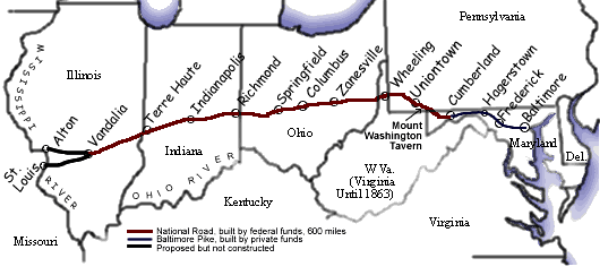If your ancestors migrated to Iowa in the 1800s from eastern states, it's possible they traveled the National Road. Extending 600 miles from Cumberland, Maryland, it crossed the states of Pennsylvania, West Virginia, Ohio, Indiana, and Illinois, terminating at Vandalia.

The National Road, in many places known today as Route 40, was built between 1811 and 1834 to reach the western settlements. It was the first federally funded road in U.S. history. George Washington and Thomas Jefferson believed that a trans-Appalachian road was necessary for unifying the young country. In 1806 Congress authorized construction of the road and President Jefferson signed the act establishing the National Road.
The National Road was the primary route immigrants and east coast settlers used in their western migration. Small towns sprung up along the pike. Fueled by guides published for emigrants that contained articles "containing glowing accounts of the beauty, advantages, and fertility of the Iowa country” combined with a fatal epidemic of cholera and drought in the middle states, migration to Iowa soared.
During the years 1854 to 1856, one account states: " 'The immigration into Iowa the present season is astonishing and unprecedented'. 'For miles and miles, day after day, the prairies of Illinois are lined with cattle and wagons, pushing on toward this prosperous State. At a point beyond Peoria, during a single month, seventeen hundred and forty-three wagons had passed, and all for Iowa.' '' Another account: "The Immigration to Iowa this season [1855] is immense far exceeding the unprecedented immigration of last year, and only to be appreciated by one who travels through the country as we are doing, and finds the roads everywhere lined with movers." The steam ferry at Rock Island [Burlington, Illinois] running one hundred trips a day was not able to accommodate the traffic.